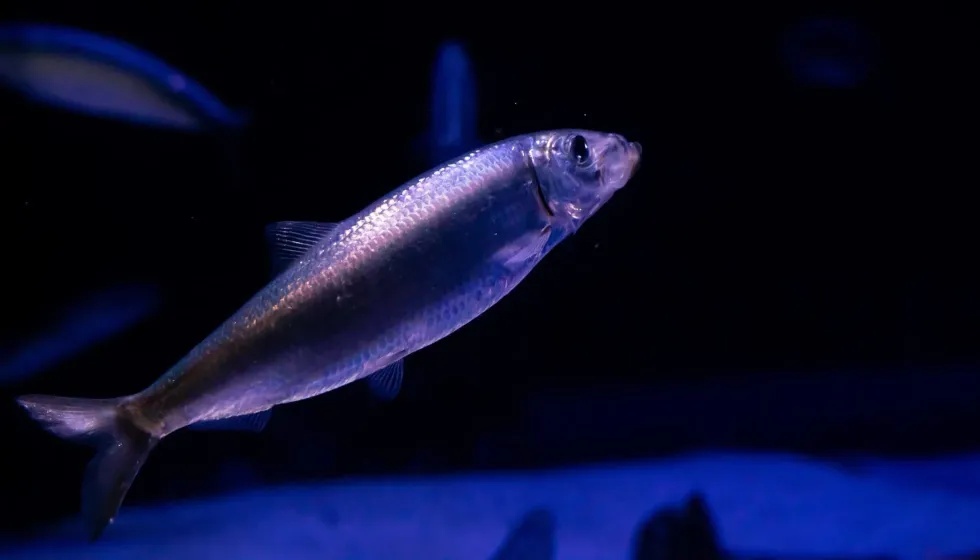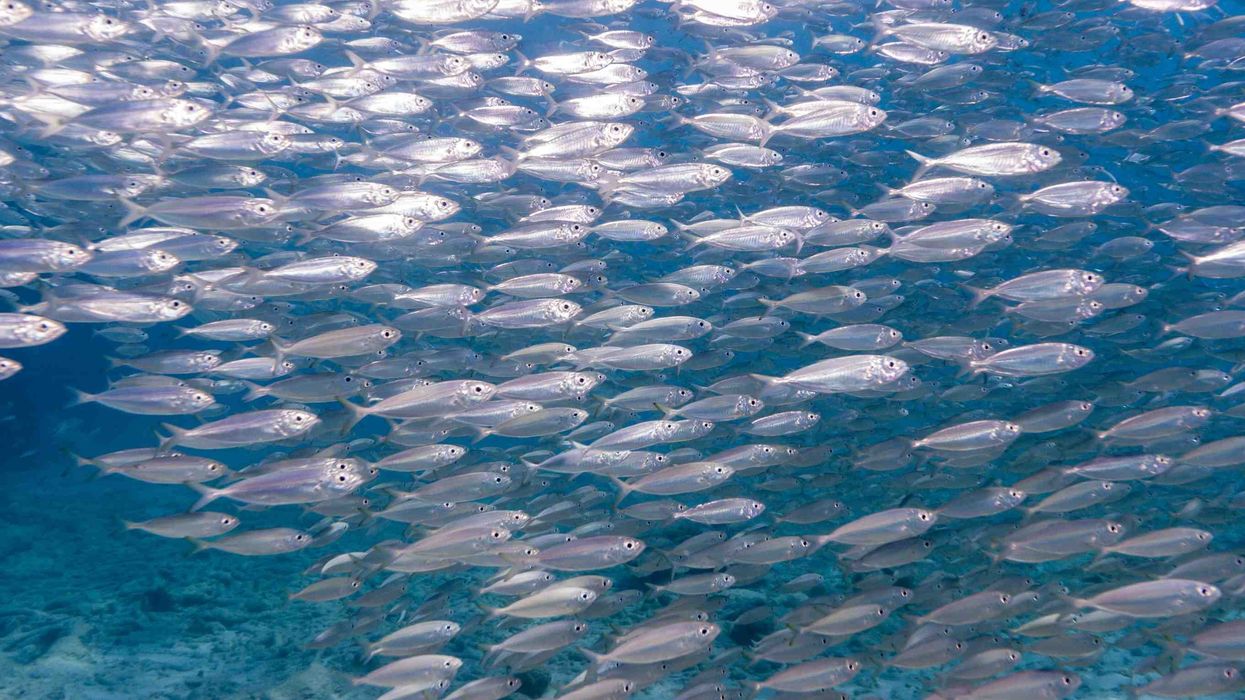The Atlantic herring (Clupea harengus) are ray-finned fish belonging to the Clupeidae family. They are small-headed, streamlined, and have a torpedo-shaped body. Atlantic herring are silvery creatures with a blueish-gray upper side and a forked tail fin. Their habitat consists of both sides of the Atlantic Ocean, primarily in coastal or pelagic waters.
As for the distribution of the Atlantic herring, they can be found in the coastal regions of Northern Europe to Greenland and Northeast America's coasts. They are carnivores or to be more specific planktivores and feed on tiny creatures like fish larvae, krill, and copepods.
Atlantic herring fishery is very popular as it boosts the economy. After fishing, they are either eaten, used as baits, or in zoos and aquariums as food for other animals.
They are an important part of Herring fishery operations. Let’s find out some more information and interesting facts about this fish.
Learn more about some other fish from our mutton snapper facts and meagre fish facts pages.
Atlantic Herring Interesting Facts
What type of animal is an Atlantic herring?
Atlantic herring(Clupea harengus) is a fish belonging to the family Clupeidae. Their habitat, as the name suggests, includes both sides of the Atlantic Ocean, especially in the coastal waters. They are most frequently seen in the Nordic Atlantic Ocean. They are also known as sea herring and sild. Atlantic herrings are a type of herring.
What class of animal does an Atlantic herring belong to?
The Atlantic herring fish belong to the Animalia kingdom and class Actinopterygii.
How many Atlantic herrings are there in the world?
Atlantic herring are listed under the Least Concern category, meaning they are found in abundance and are at the lowest risk of going extinct. They have a fast reproductive rate and their population is increasing. Atlantic herring can school in huge numbers and can at times have several billion fish in one school.
Where does an Atlantic herring live?
Both sides of the Atlantic Ocean like the Gulf of Maine and the Gulf of St. Lawrence have been beautified by the presence of large schools of the silvery Atlantic herring. They are forage fish and move in huge schools near coastal regions and fishing banks.
What is an Atlantic herring's habitat?
The Atlantic herring can be found shoaling and schooling across western North Atlantic waters such as the Gulf of St. Lawrence and the Gulf of Maine. Their habitat includes Davis Straits which is the northern arm of the North Atlantic Ocean.
Atlantic herring live in the Nordic Atlantic waters in the Norwegian Sea, the North Sea, and the Skagerrak. Atlantic herring are also found in the northern part of the Arctic.
Who do Atlantic herring live with?
Atlantic herring live and move in groups called schools. It means that they swim in groups in the same direction in a coordinated manner. Atlantic herring can school in large numbers which can, at times, equal to several billion fish in one school.
The schools of thousands or even millions of fish travel across the open oceans. They follow a precise spatial arrangement to maintain a constant cruise speed. The individual schools of the Atlantic herring usually travel in a triangular pattern. The pattern consists of their spawning grounds e.g.
Southern Norway, their feeding ground e.g. Iceland, and their nursery grounds e.g. Northern Norway.
How long does an Atlantic herring live?
Atlantic herring species is one of the most populous species in the family Clupeidae. They grow quickly and can live up to 15 years. Though the females release numerous eggs during the spawning season, both male and female species tend to die after spawning.
How do they reproduce?
Breeding in the case of Atlantic herring occurs via the method of spawning. The process of spawning entails a large group of fish release their eggs and sperms at the same time.
The process of fertilization occurs outside the body. However, a single school might have different spawning components, and spawning can be done at different seasons. They reach sexual maturity when they are three to five years old.
Atlantic herring spawn in estuaries, offshore banks, and coastal waters. The females can release 20,000-40,000 eggs simultaneously with masses of milt released by the males. The eggs and the milt can mix freely in the seawater. The eggs sink to the sea bed. The sticky eggs cling to gravel and weed and mature in one to three weeks.
What is their conservation status?
According to the IUCN, the Atlantic herring, or common herring, is listed as of Least Concern, meaning these species are found in abundance and are at the lowest risk of going extinct. They have a fast reproductive rate and are one of the most populous fish.
Atlantic herring can congregate and school in huge numbers and can at times have several billion fish in one school.
Atlantic Herring Fun Facts
What do Atlantic herring look like?

Atlantic herring, or Clupea harengus, are ray-finned fish belonging to the Clupeidae family. They are small-headed, streamlined, and have torpedo-shaped bodies. Atlantic herring have silvery iridescent sides with bluish-gray metallic-hued backs and a deeply forked tail fin.
Their bodies are covered with scales that are large, thin, and attached loosely. The Atlantic herring teeth are small and weak and arranged in an oval shape at the roof of the mouth. The lower jaw is slightly protruding from the upper jaw.
How cute are they?
Atlantic herrings are small but cute looking with silvery and bluish bodies and a forked tail.
How do they communicate?
Scientists have been experimenting with how fishes communicate with each other. It is an ongoing attempt to get a proper idea about their communication method.
Regarding the Atlantic herring, scientists believe that the fish emit FRTs, high-pitched click-like noises. It is noticed that those noises usually happen during the night when the Atlantic herring form schools near the sea surface.
To get to the bottom of the sound, scientists have taken the help of infrared cameras and underwater microphones called hydrophones. Those gadgets helped in determining the fact that the fishes were producing these sounds at the very moment that bubbles emerged from their anuses.
There have been various studies about the FRTs, whether they are advantageous or disadvantageous for the Atlantic herring.
Recent observations on killer whales hunting for herring hint that they can be actually beneficial for the herring. The bubbles produced by herring FRTs can actually confuse big predators like whales making it difficult for them to attack the small Herring.
These small fish have excellent hearing, and as a school, they can react very quickly to evade predators. Herring schools can form a vacuole imitating the looks of a doughnut from a spotter plane. This vacuole helps them maintain a certain distance from a moving scuba diver or a cruising predator like a killer whale.
How big is an Atlantic herring?
The length of an adult Atlantic herring can range between 8 – 15 in (20 - 38 cm).
How much does an Atlantic herring weigh?
The weight of this small fish can go up to 1.1kgs (2.4lb).
What are the male and female names of the species?
The male and female Atlantic herring or Clupea harengus do not have different names. These species have a few other names like sperling, sardine, common herring, labrador herring, sea herring, and sild.
What would you call a baby Atlantic herring?
The baby Atlantic herrings do not have any different names and are known as Atlantic herrings.
What do they eat?
The food of Atlantic herring is mainly tiny microorganisms. They convert zooplankton into fish while eating copepods, arrow worms, and Chaetognatha. Their pelagic prey includes amphipods like hyperia spp., hyperiidae, snails, mysids, molluscan larvae, fish eggs, krill, small fishes, and pteropods.
Are they dangerous?
No, they are small carnivorous fishes whose food consists of tiny floating animals. These species are also quite fragile and sensitive.
Would they make a good pet?
No. The Atlantic herring species live in large schools, are quite sensitive to any chemical change in water, and have sensitive health requirements. All these reasons make them not suitable as good pets.
Did you know...
The Atlantic herring keep their mouths open while swimming. By doing that they can filter the planktons, which go through their gills. It is also said that Southern herrings can live up to 25 years. Herring fishery is commercially important in New England and Canadian areas like the Bay of Fundy and off Nova Scotia.
Eating Atlantic herring fish
The Atlantic herrings have been a major source of food for human beings all across the world. Catching them for commercial reasons are being done for hundreds of years.
Common herrings are sold and eaten salted and pickled. They are also found smoked, fermented, or are canned as Sardines. They are also used for making fish oil and are considered a good source of vitamin D and omega 3 fatty acids.
Catching Atlantic herring
The Atlantic herring fishery or fishing is popular both commercially and for recreational purposes. Herrings are considered a popular baitfish by recreational fishermen.
They are also used as food for other animals in zoos and aquariums. The economy of New England and the Canadian provinces like SW Nova Scotia is a lot dependent on the availability of Atlantic herring fish. Even you can try your hand if you want to catch Atlantic herring.
Here at Kidadl, we have carefully created lots of interesting family-friendly animal facts for everyone to discover! Learn more about some other fish from our Black Sea bass facts and sandperch facts pages.
You can even occupy yourself at home by coloring in one of our Atlantic Herring coloring pages.









